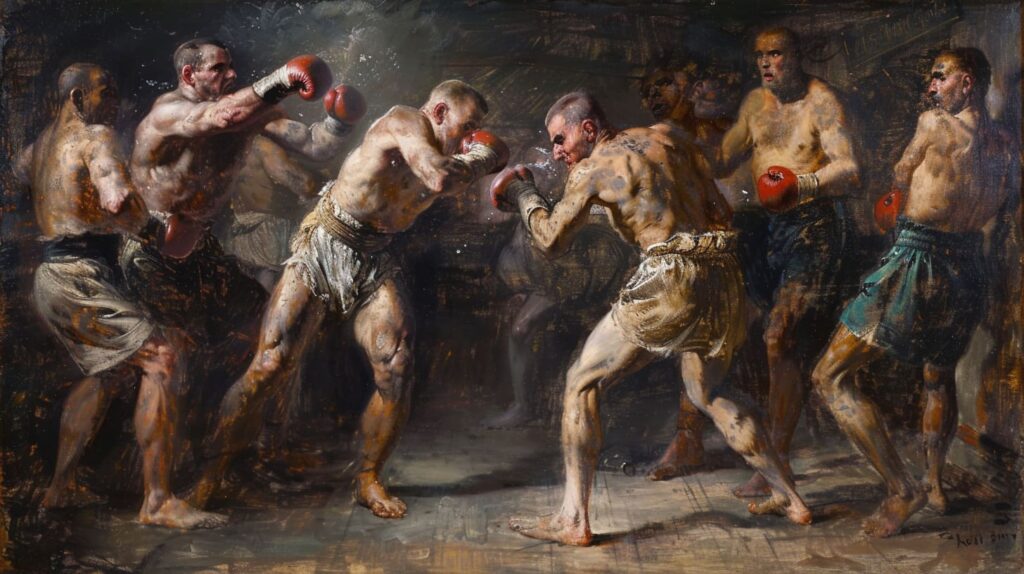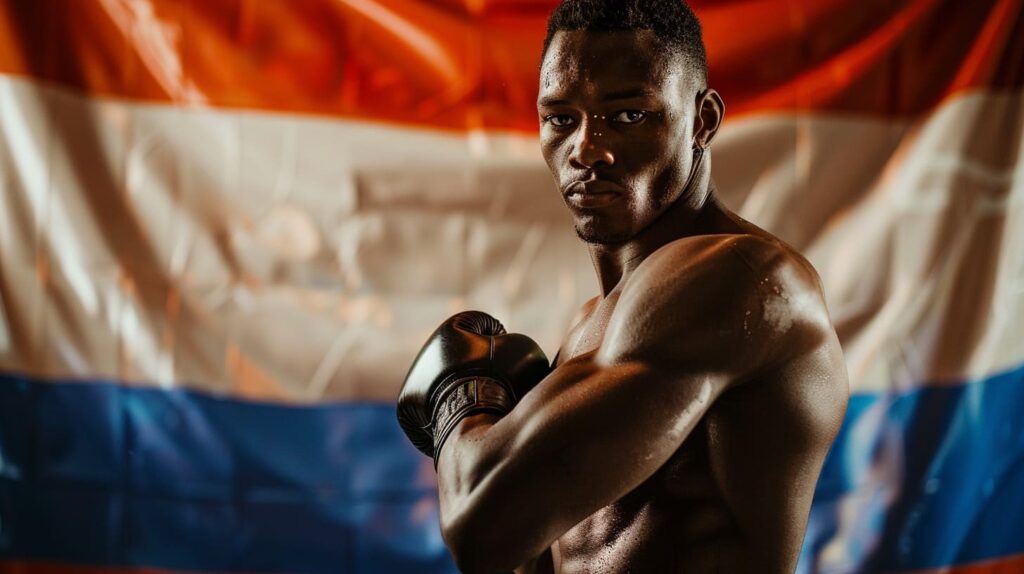At the core of Dutch Kickboxing lies a harmony of formidable techniques, where each kick and punch is a note played with utmost intensity. Let’s take a walk through the origins of this fierce fighting art, charting its rise to prominence on the international stage, and explore the distinctive elements that make it stand apart from the rest.
Key Characteristics of Dutch Kickboxing
In the symphony of martial arts, Dutch Kickboxing stands out for its unique rhythm and technical prowess. Here, the emphasis on rigorous conditioning meets the elegance of versatile striking techniques, creating fighters who are as strong as they are swift.
This style is not just about throwing punches and kicks; it’s about the strategic choreography of movement. Power and precision are the goals, and Dutch Kickboxers train hard to achieve them. But what exactly sets Dutch Kickboxing apart, and how do these fighters train to embody such power and agility?
Central Pillars of the Dutch Kickboxing Phenomenon:
- Foundational Techniques & Strategies:
- Mastery over basics
- Unyielding offense paired with strategic defense
- Undeniable Physical Attributes:
- Strength, endurance, and agility
- A relentless pursuit of fitness perfection
- Versatile Striking Techniques:
- A diverse arsenal of strikes
- A unique blend of punches, kicks, and knee strikes
- Dynamic Footwork:
- Intelligent movement to control the ring
- Offensive and defensive strategies rooted in agile footwork
With these characteristics as the blueprint, Dutch Kickboxers hone skills that echo through the annals of combat sports, continuing to influence and inspire fighters across the globe.
Historical Background

In the late 1960s and early ’70s, the sporting landscape was ripe for something fresh sport, and that’s exactly when Dutch Kickboxing began to carve its niche.
What started as a blend of Karate and Western boxing soon transformed into something greater thanks to influential figures like Jan Plas. Plas not only introduced kickboxing in the Netherlands but also founded the first kickboxing gym, planting a seed that would grow into a mighty oak.
Throughout the years, icons such as Rob Kaman and Peter Aerts, dubbed ‘The Dutch Lumberjack’, stamped their authority on the sport. Their contributions went beyond winning titles; they shaped the very essence of what we know as Dutch Kickboxing today.
Evolutionary Milestones in Dutch Kickboxing:
- Late 1960s to Early 1970s: Birth of a new fighting style, blending traditional martial arts with Western boxing.
- Training Revolution: Introduction of Western training methods and emphasis on actual full-contact fighting.
- Cultural Impact: The rise to international prominence as Dutch fighters compete and triumph on the world stage.
This evolution wasn’t just about the development of new techniques; it was about a change in mindset—applying relentless pressure, fostering aggression, and prioritizing the importance of conditioning. Witnessing this transformation is like watching a dance evolve, where the simple steps become part of a much more intricate and impactful performance.
Training and Preparation
The training of a Dutch Kickboxer is legendary, mirroring the intensity and sophistication of their fighting style. Each session aims to forge not just a well-rounded fighter, but an athlete capable of outlasting and outperforming their opponent in each aspect of the sport.
Typical Training Regimen Breakdown:
- Daily Practices: These often include a combination of cardiovascular training, strength work, and technical drills. Punctuality and consistency are key.
- Technical Skills: A bulk of focus is aimed at refining strikes—punches, kicks, and defensive moves—and fighters spend hours honing them to perfection.
- Pad Work: Essential for speed and precision, fighters practice combos with a coach donning pads, reacting to targets with split-second timing.
- Heavy Bag Work: To build power and simulate fight conditions, the heavy bag becomes a main sparring partner, absorbing endless rounds of strikes.
- Sparring Sessions: Regularly scheduled spars mimic real fights, testing a fighter’s ability to apply techniques and strategies against a resisting opponent.
When you think about conditioning, it’s the backbone of any kickboxer’s training. Hallmark qualities such as resilience, stamina, and flexibility are not born purely out of desire; they are cultivated through relentless, well-structured routines.
Essential Conditioning Exercises Include:
- Interval running and cycling for explosive cardiovascular endurance
- Plyometric drills to enhance dynamic movements and agility
- Resistance training to build the muscular strength necessary for delivering and absorbing hard hits
In essence, these combat maestros are not just practicing a sport; they are in a constant state of preparation for physical chess, where every moved piece holds the potential for victory or defeat.
Competitive Structure

Matches are orchestrated with precision, following an established set of guidelines that ensure fairness and safety for all fighters. This includes everything from permissible strikes and protective equipment to the number of rounds and the duration of each.
Key Elements of Dutch Kickboxing Matches:
- Round Structure: Fights are typically divided into several rounds, with each allowing fighters to showcase their skill and stamina.
- Weight Classes: Classes categorize fighters into divisions based on body weight, ensuring matches are between equally matched combatants.
- Judging Criteria: Judges score fighters on their successful strikes, defensive maneuvers, and overall ring control.
The sport’s impact resonates beyond the Netherlands, with international competitions drawing fighters from all corners of the world. Such events not only showcase the prowess of Dutch Kickboxers but also elevate the global standard of the sport.
Worldwide Competitions Shed Light On:
- The diversity of tactics and strategies employed by fighters from different countries
- The exchange of cultural fighting techniques on the global stage
- The unifying effect of the sport, bringing together diverse backgrounds in the spirit of competition and respect
Influence on Other Martial Arts
MMA, a battlefield of varied fighting styles, has welcomed Dutch Kickboxing with open arms. Numerous MMA fighters embellish their arsenals with techniques borrowed from the Dutch school—sharpening their strikes, enhancing their footwork, and adopting the relentless Dutch pace.
The Influence Is Clear Through:
- Incorporation of Dutch low kicks and punch-kick combinations in MMA
- Adjustment of traditional training methods to include Dutch drills and conditioning
- Success stories of MMA champions who credit their stand-up prowess to Dutch training philosophies
Cross-training has become a norm, merging skill sets across different disciplines. With each passing day, the lines between styles blur, creating a new, hybrid breed of fighter—quick on their feet, versatile in their attack, and unwavering in spirit.

